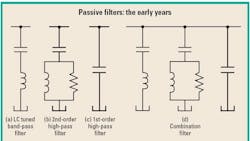Drive researchers have been working on active filters, sometimes known as adaptive compensators, for several years. These devices offer better attenuation of a wider range of harmonic currents than present technology, which includes passive filters, and two non-filter solutions– line reactors and multiphase converters.
Implementation in the U.S. is somewhat slow because of their high price and operating costs. But as drive developers work to lower costs, you can expect to see wider application of these devices in two to five years.
The current problem
Phase-controlled thyristor rectifiers and capacitor input-diode rectifiers are the two main sources of current sinewave harmonics with electric drives. Dc motor drives widely use thyristors, whereas ac motor drives use diodes. These devices do not draw the current steadily, instead they switch it on and off approximating a sine waveform. This technique, though, usually results in distortion of the fundamental frequency of the sine wave. It's this distortion, or companion harmonics, that can cause so much trouble.
The harmonic currents often flow back to the utility source. This "dirty" power may then be sent out and affect the operation of any electrical or electronic equipment, including the converters that caused the harmonics in the first place. The effects range from reduced power factor, transformer and motor insulation failure, and nusiance tripping, to expensive replacement of damaged equipment.
Attempts have been made to control this problem. Regulations, such as IEEE-519 in the U.S., set limits on the amount of harmonic current that converters can inject into power lines. Yet, this regulation is not mandatory, plus it is open to interpretation. So harmonics still get into the system, which means engineers need to use some type of filter to protect equipment from potential damage.
Moving from passive to active
The most common harmonic filter is the passive filter. Passive filters act as harmonic current sinks, shunting the harmonics from the static power converters. However, these devices have some inherent limitations.
The amount of impedance they can compensate depends on the ac source impedance. Usually, this factor is not accurately known, and it varies with the power system configuration. If source impedance is low, passive filters have difficulty providing the required attenuation.
Also, passive filters are sensitive to variations in the supply frequency. This sensitivity affects their ability to compensate the harmonics, especially if the filters are tightly tuned.
Another problem involves a parallel resonant circuit as viewed from the load. Load harmonics may excite this circuit, causing a large current between the source and the passive filter, as well as excessive harmonic voltage across the load.
Likewise, a series resonant circuit as viewed from the ac source can also cause problems. Voltage harmonics from neighboring loads may excite these circuits, forcing a large harmonic current into the passive filter. It may also cause a large voltage across the load, which, together with the current, may blow the passive filter, impair the capacitor, or overheat other electrical equipment.
In addition to all that, passive filters eliminate only selected orders of harmonic current.
Active filter devices, on the other hand, behave as harmonic generators, creating waveforms that oppose and cancel the harmonic current components. These devices handle the full range of harmonics. They simultaneously compensate for multiple orders of harmonics, from 2nd to 30th order, depending on the design of the control bandwidth.
Even if harmonic currents exceed these devices' capacities, they continue to function, compensating for those harmonics within their capacity. In addition, they are insensitive to source impedance and voltage frequency.
They can also solve other power problems. For one, they provide reactive power compensation, which can improve power factor to unity and prevent voltage drop. Their ability to compensate for negative phase sequence components relieves the burden on the generator.
Compensation in action
An active filter has two components, a power circuit and a control circuit. The power circuit consists of an IGBT inverter similar to ones used in ac motor drives, and a dc capacitor for energy storage. For fast control of the current, the capacitor is actively charged to a higher voltage than the line-to-line source voltage.
A harmonic detection circuit in the control portion of the filter senses twophase load currents and processes them to extract the harmonic currents. In a phase-controlled SCR dc motor drive, for example, the load current IL appears as two rectangular waves. Each wave contains the fundamental current IF and the harmonic current IH.
The filter produces a compensation current IC with a magnitude matching the load harmonic current IH, but in the opposite direction, that is, -IH. This effectively cancels the harmonic current components circulating in the load. Hence, the source IS is simply the fundamental current IF. The control circuit then generates a PWM signal that it sends to the IGBT inverter of the power circuit.
Active filters are placed across the source, in parallel to the load. All that is needed for installation is to connect it to a power source and to the input circuit of the load equipment. Even when multiple active filters are connected in parallel, mutual interference can't occur.
And because active filters don't require capacity to handle the fundamental component of the sine wave — just the harmonic components — they are usually compact devices.
Around the corner
To reduce costs, several combinations of active and passive filters have been proposed and are under investigation. These structures reduce the power-rating requirement of the active filter part, thereby cutting system costs.
Dr. Xiang is an electronic research project engineer for Baldor Electric Co., Fort Smith, Ark.
